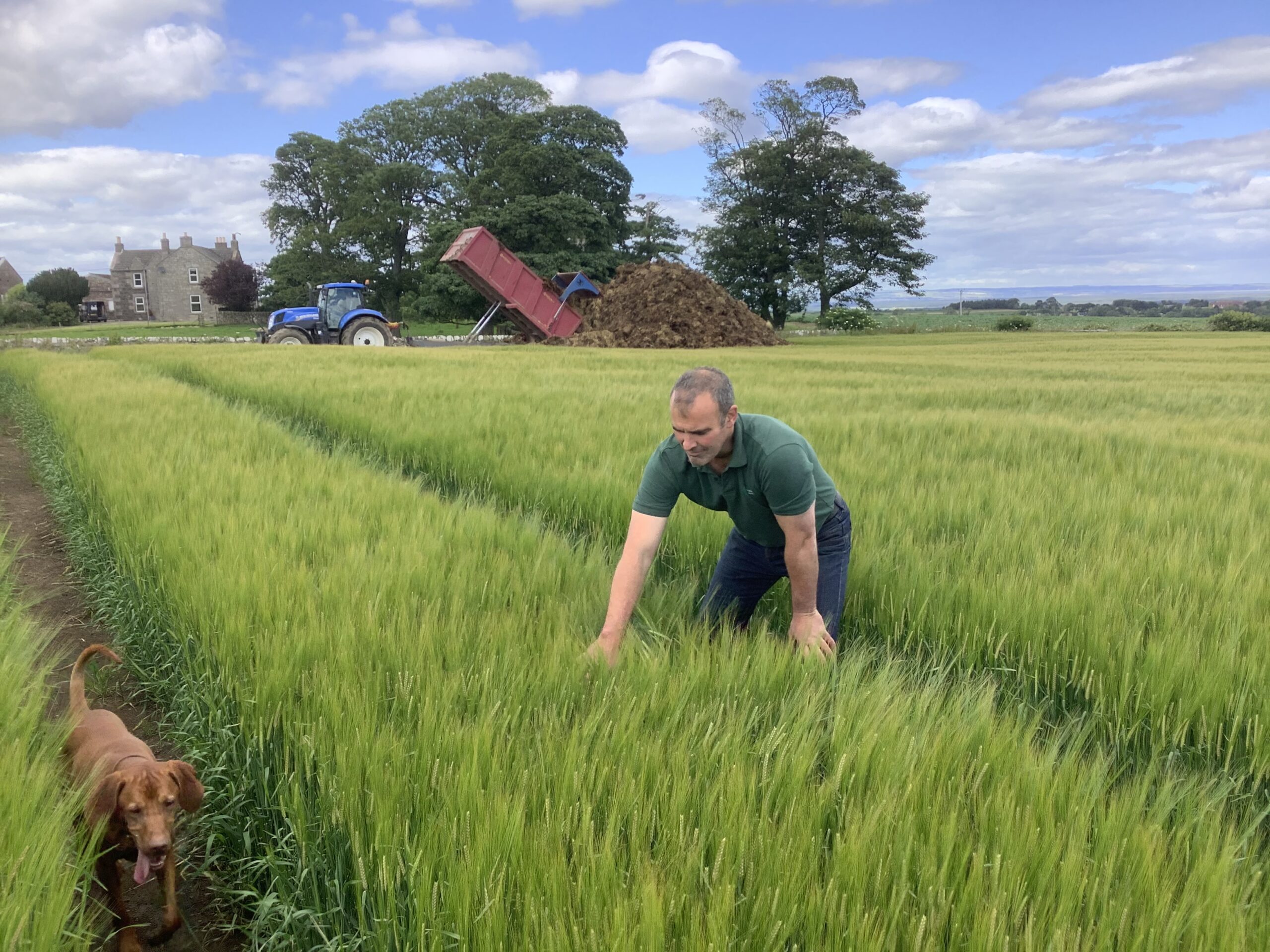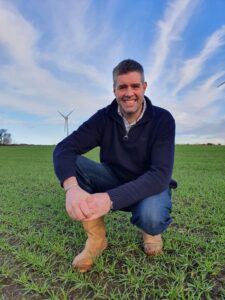
Scottish Agronomy growers dominated the spring barley category in the 2020 Yield Enhancement Network (YEN) awards this week. Fife grower Dave Bell took gold for best spring barley yield 11.3t/ha while Peter Chapman of Aberdeenshire won gold and Duncan Wilson at Glamis won bronze for best potential yield for spring barley.
Dave, of Upper Magus Farm near Strathkinness, won gold for spring barley for outright yield, growing a 11.3t/ha crop which made malting grade; and also a silver for potential spring barley yield achieving 84% of 14.1 t/ha. He won a second gold for best potential winter barley yield.
He puts his success down to early drilling before the drought set in, a focus on IPM to keep the soils active and keeping the crops clean from the very start with good soil management. Having livestock on the farm and a good crop rotation with soils that support access to nitrogen has helped, in his view.
“It means a lot to be recognised in the awards, and fantastic to show that we can boost yields following IPM and best practice, and not over applying plant protection products. As much as pushing yield is important, I need to keep a keen eye on margin – it has to stack up.
“The biggest challenge now is to replicate those yields on the farm average. Although the award shows we can achieve it, now I have to take the rest of the farm with it. There is no silver bullet, it’s a combination of multiple marginal gains and attention to detail, as well as a good team and using trusted independent advisors such as Scottish Agronomy, SRUC and AHDB and their insights and research to make key decisions.”
The spring barley achieved malting quality at under 1.6% grain nitrogen using standard farm practice nitrogen applications for malting barley. Being proactive with the information gains from ADAS YEN soil nutrient analysis and in-season tissue analysis has been a key factor for a healthy crop. Dave was sponsored by Limagrain/Nickerson, Senova and Agrii.
Peter Chapman of South Redbog Farm, near Strichen in Aberdeenshire won a gold award for achieving a yield 9.7t/ha of spring barley which was 87% of its maximum potential yield of 11.1t/ha yield. He also won a bronze for outright yield of 9.7t/ha of spring barley and a bronze for outright wheat yield of 14.8t/ha.
He says the growing conditions this year were ideal for his farm. He also puts success down to resilient soils in drought conditions, having applied organic manure to his arable ground for the last 30 years. The only change he made was to increase nitrogen to his YEN crops by approximately 10% compared to his standard farm practice.
“It’s been a six-year battle to win an award, but this was the year for it! The growing conditions were advantageous and the dry weather suited our sandy clay loam soils. There were a lot of high yields on farms in Aberdeenshire, and with the low rainfall there was not the same disease pressure.
“We haven’t cracked the job. The weather has a lot to do with it, but we are using all the information and tools we have available to do the best job we can.”
Tissue and grain analysis last year showed the growing crops were low in copper and potash.
“We applied significantly more copper this year which has helped, and next year, we’ll be adding a liquid NKS fertiliser to address that requirement at peak growth.”

Peter values advice from his agronomist Iain Learmonth of Gardiner ICM Ltd, also an Aberdeenshire farmer 2020 YEN award winner for best percentage of potential yield (102% of 13.9 t/Ha), and Scottish Agronomy’s Knowledge Hub which shares information from the cooperative’s 20,000 trial plots:
“I find the trials information very valuable – it’s a mine of information there that can be used to maximise potential output.”
Peter’s entries were sponsored by Limagrain/Nickerson and Hutchinsons.
Duncan Wilson, Farm Manager of Strathmore Farming Company at Glamis, who was sponsored by AHDB, achieved bronze in the best percentage of yield for spring barley with 74% of 10.4t/ha. He said:
“It’s all about learning what improves yield. Going forward I’ll be looking at crop nutrition with a closer eye and the micro elements that make the difference.”
Eric Anderson Senior Agronomist at Scottish Agronomy said:
“The Yield Enhancement Network, as an open competition platform, connects agricultural organisations and farmers striving to improve crop yields. It is about farmers, agronomists, suppliers and scientists all working together with a common goal.
“These awards are testament to the hard work and attention to detail of our members, who are outward looking, prepared to try new methods and are ambitious to get the best they can from the crops. It’s encouraging to see soil and IPM play such a part in the success of these yields. Ultimately high yields and appropriate inputs boost profitability. It is a mindset about the learn, the taking part and selfless sharing of information amongst peers. We should celebrate the success achieved by all in the face of an extremely challenging season for so many reasons.”
Minimising yield loss and the benefits of YEN insights
Eric Anderson, Senior Agronomist at Scottish Agronomy, explains the benefits of YEN:
“We are looking to understand how to minimise yield potential losses. Farming in essence is just loss management you start at 100% and you minimise your losses. Before wheat seeds leave the bag there is the potential to produce 18-20 t/ha of grain in Scotland, yet we are regularly failing to realise even 60% of this. We need to understand the reasons why and target how we can address the challenges.
“ADAS has analysed all the YEN data and one of the consistent findings is that crops with high ear numbers are positively associated with yield. Each participant receives over 60 explanatory metrics which builds their own vital personal database.
“Tissue analysis during key periods in the growing season gives insight into the crop’s health and frequency of possible nutrient deficiencies. This allows growers to take actions in season on nutrient deficiencies with foliar applications in conjunction with the key fungicide timings. Samples of the crops are also taken at harvest, and that has shown us that crops with a high biomass are positively associated with yield. So really, we should be managing the crop with those targets in mind.
“Through the YEN camaraderie and the desire to develop the confidence to do better than “Best Practice”, awards aside, everyone is a winner through the ability to benchmark their performance with components of yield analysis combined with tissue and grain analysis. With dedication and enthusiasm, it provides the opportunity to share and understand ideas and build upon incremental gains.
Within the YEN data set – which admittedly is skewered– there is still a lot of variation. Most modern varieties produce high yields but growing is an art and there are millions of permutations of the decisions taken to grow a crop. Each correct decision results in a small improvement of spatial and temporal yield within a field. Attention to detail and soil management are key to higher yields, which are often more consistent where animal manure is applied within the rotation.
“Despite difficult establishment conditions, yield potentials were only slightly reduced. This reflects improved soil health and soil structure enhancing crop rooting and reliance. Without organic matter incorporation it does not preclude high yields but it does make the achievement of high yields more difficult. Above all else, critical analysis and determination to push boundaries of what is achievable are common threads.
“Looking ahead, with ecosystem services becoming an aspect of conditionality that many will need to need to embrace, carbon foot printing and Net Zero is the next challenge. This will be driven by nutrient use efficiency and yield.
“With the transition from the current BPS area-based payments in Scotland from 2024, break even yield per hectare will undoubtedly increase. Productive agriculture will need to be balanced with promotion of biodiversity.”